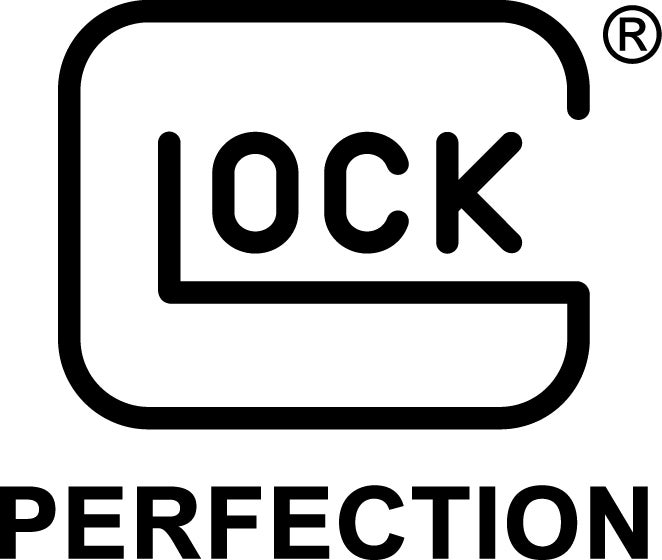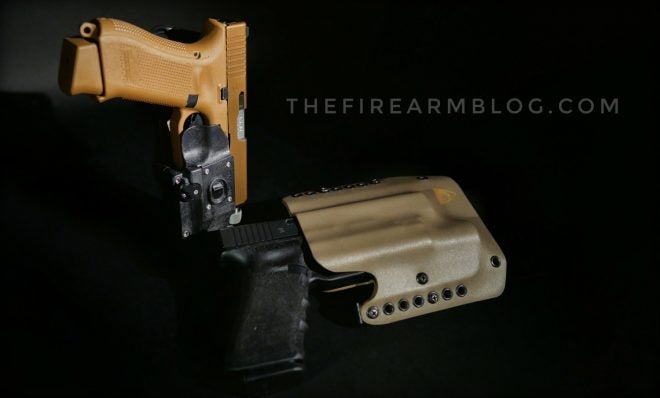Hello everyone and thanks for joining us for TFB’s Concealed Carry Corner where once a week we’ll meet up to discuss the guns, gear and techniques surrounding legally packing heat. Like most of you, I have a section of the closet filled with discarded holsters and magazine carriers from different periods of my CCW life. From a suede inside-the-waistband wheelgun holster to polymer drop leg rigs, you name it, I’ve bought it. We can discuss the different levels of holster retention devices in a future episode, but today let’s take a look at a topic geared towards new shooters and new permit holders: should you buy and use leather or Kydex style holsters?
Above: A GLOCK 19X with a KKM Precision threaded barrel In The SureFire Masterfire holster and a GLOCK 17 in a DSG Arms holster.
If you walk into a local gun shop to buy your first carry pistol, the chances are you are also walking out of that establishment with a new holster. And like most gun counter advice, your choice will be decided by either the employee’s experience (or lack thereof) or the latest Instagram post shot by a highly vascular trainer running sub one-second competition drills.
In the last decade, concealed carry holsters have moved from traditional materials and designs, like canted leather with a thumb break, to rigid open-top polymers. For those of you buying your first holster, relax, you are going to be buying at least two or three models or types before you find the one that fits your style and routine. Let’s face it, you don’t get intimate knowledge of guns and gear without some trigger time. But hopefully we can offer you a bit more information so you can make better informed purchasing decisions the first time around.
For ten years, both my Sig and GLOCK pistols called leather holsters home. After a few weeks of break in time, a quality leather setup becomes soft, form-fitting and comfortable. On the other hand, rigid Kydex holsters hold their shape to assist with reholstering and can provide positive retention without the need for a thumb break. As a reminder, there’s no right answer to the Kydex versus leather debate: your use case, location, firearm and other decisions should define your choices.
To offer a bit of insight into the world of concealed carry holsters, I reached out to two industry members for their take on the leather versus Kydex debate. One has over 40 years of experience making leather holsters, the other is a relatively new entry into the Kydex holster world. Both have experience and perspectives that CCW shooters should take into account when buying a new holster.
Gene DeSantis, DeSantis Holsters
https://www.desantisholster.com/
1) How long has DeSantis been making holsters? If you had to estimate, how many holsters has the company produced in its history?
We have been making serious holsters since 1972 and the numbers are now in the millions.
2) What qualities should a good holster provide the shooter?
Concealment holsters should be first and foremost concealable. They should hold your weapon close and tight. When possible they should provide covering protection from all sharp points of the weapon’s exterior. They should hold the weapon securely, with or without being equipped with a secondary retaining device.
3) In recent years Kydex has gained in popularity for a holster material. How do you feel about polymer holsters in general?
Plastic (polymer) holsters are fine and they will take more abuse then their leather counterparts, however leather holsters, given reasonable care, will last for decades.
4) What advantages does leather offer over Kydex?
Leather holsters are traditional, great looking, comfortable, and won’t be replaced completely with plastic anytime soon. Leather holsters are much more forgiving for a weapons fit. An example of this would be; a leather scabbard made for a 45 Government model can also hold a Browning Hi power, although not a perfect fit, it is an acceptable substitute. A polymer holster made for a Hi Power can’t be used for the 1911. We make one leather holster that can hold a large variety of weapons and is ambidextrous. We can’t do that well with a rigid formed polymer holster. Finally, leather is much easier on a firearm’s finish.
Darrel Collins – Holster Maker, Justified Warfare Solutions
https://justifiedwarfaresolutions.com/
1) What is Kydex? How is it used to make holsters, carriers and other gear?
Kydex is a line of thermoplastic acrylic-polyvinyl chloride composite engineered for thermoforming fabrication, and combines properties of both the acrylic and the polyvinyl chloride components. From acrylic, it obtains rigidity and formability; from PVC, toughness, chemical resistance.
Kydex is a relatively hard thermoplastic, with a hardness of 90 on the Rockwell R scale. This hardness, combined with a grained surface, increases its abrasion resistance. Other characteristics are low flammability, waterproof, scratch resistant, holds its shape better, will not stretch or shrink under normal conditions and has low friction.
There are two ways to make a holsters or sheath with kydex. Both ways use heat to make the plastic formable then you can use a press combined with a mold gun to press the kydex into shape around the mold using pressure. Another way is to use vacuum forming where a vacuum is used to pull the plastic over a mold until it cools and becomes rigid once again.
One can use a mold device or the real object to make a holster, knife sheath or magazine carrier. It takes skill and knowledge and experience to get the kydex to form right and be usable after it is molded. But the equipment needed to make the holsters is not overly expensive so you don’t have to mortgage your house to get the tools and equipment to make Kydex products.
2) What advantages does Kydex offer over other holster materials?
Kydex offers low flammability, waterproof, is scratch resistant, holds its shape well, will not stretch or shrink under normal conditions, has low friction, and easy to clean. All of these combined attributes make it last a long time without showing wear and tear so they are well worth the money because they will last for years. You get it custom made for your pistol, even if you use a light or laser. You can get customized art to add bling to the usefulness of the kydex gear as well. Kydex is usually less expensive than high end Leather holsters too.
3) Have you used a leather oldster in the past? What made you change?
I have used leather holsters and still do, but mostly for open carry, like going to the range. Leather holsters are very nice and they last a long time, but do require more maintenance than kydex to keep them in good shape and do cost more usually than a Kydex holster. Then there are hybrid holsters that combine leather and kydex. These are nice as well. I have used these too but I find a simple Kydex holster to be the most comfortable and most reliable for everyday carry. Easy to use, easy to clean.
Holsters are like pistols, everyone has their own preferences and reasons to use the type they use. AFter carrying for over 20 years and going thru many holsters I would always recommend buying a quality holster of which ever type you prefer for everyday carry. It will fit your gun and be way more comfortable than a “store bought” type of holster. Better comfort means you will use it more often, better fit means you can use it better and it will be safer all around, all the while protecting the investment of your pistol.
What are you guys using as your everyday carry (EDC) holster? Are you a diehard leather shooter or have you always been a polymer or Kydex user? Please let us know in the comments section below.
See you next week.
TFB’s Concealed Carry Corner is brought to you by GLOCK

 Your Privacy Choices
Your Privacy Choices

